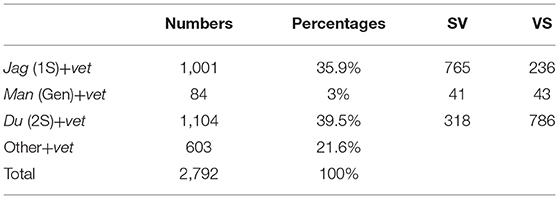- Department of Linguistics, Stockholm University, Stockholm, Sweden
From the point of view of everyday talk and especially, casual conversation, it is obvious that language use is highly perspectivized with a clear focus on the speech-act participants. This fact is supported by observations regarding the pervasiveness of egophoric pronouns and the frequent use of the modal particles ju and väl in spoken Swedish. The paper demonstrates how egophoric pronouns, modal particles, and mental verbs are used to signal the epistemic perspective of the speech-act participants, i.e., when the knowledge and attention of the speech-act participants are at stake. These formally distinct resources show patterns of co-distribution that permit an analysis of forms in terms of how they signal shared/private access to events from the perspective of the speaker and the addressee.
Introduction
Egophoric contexts target the perspective of the speaking/to-be speaking subjects, and in such contexts, grammatical constructs like sentence-type, pronouns, tense-aspect marking, epistemic modals, and adverbs are used to position the speech-act participants with respect to talked-about events. This paper demonstrates how a subset of such grammatical resources are used for signaling differences and overlaps in the epistemic perspective of the discourse participants. These formally distinct devices signal different aspects of epistemic perspective in Swedish grammar and may be compared to recent accounts of epistemic marking systems in the languages of the world (e.g., Bergqvist and Kittilä, 2020; Grzech et al., 2020). The term perspective is used with reference to the notion of “multiple perspective” defined by Evans (2006), which permits a separation of epistemic and non-epistemic parameters in the configuration of different perspectives involving the speech-act participants and third parties (see Evans et al., 2018, for a discussion; cf. Bergqvist, 2015). As such, the term perspective is used in a technical sense that separates it from partly overlapping terms like viewpoint and stance (see section Status, Stance, and Territories of Information, below)1.
The main argument of the present paper is that traditional categories such as pronouns, modal particles, mental verbs, and sentence-type distinctions are prominent resources for signaling the epistemic perspective of the speech-act participants and that this is done, in unnoticed ways. When an analysis of such forms is based on how they are used in spoken discourse, it becomes evident that epistemic function determines their distribution in non-random ways. Consider Example (1):
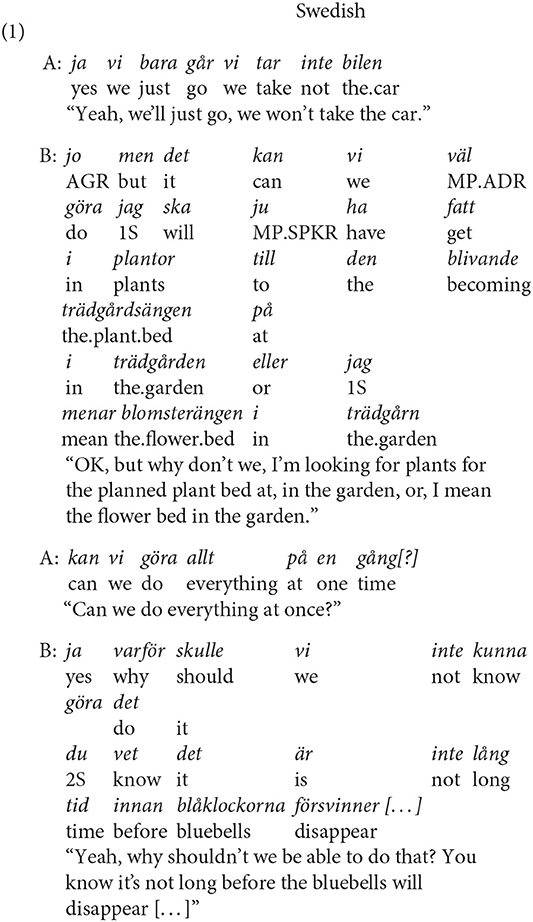
Example (1) illustrates the dialogical characteristics of spoken discourse, viz. a shared context, a high level of interactiveness, and personal expressiveness (see Leech, 1998; Leech and Svartvik, 2002). These are reflected in the occurrence of egophoric pronouns (jag, 1S; du, 2S; vi,1P), question-answer pairs, modal particles (väl, ju), and formulaic expressions targeting the perspectives of the speaker and the addressee (jag menar, “I mean,” du vet “you know”). The exchanges align the perspectives of the speech-act participants by mitigating differences of opinion and estimations of possibility/probability; it is a cooperative endeavor, whose component parts cannot be analyzed by focusing on isolated utterances in absence of discourse context. Example (1) does not constitute an exceptional instance of language use but is typical of casual talk between acquainted people, who talk for the sake of talking.
A prevalent feature of such discourse is “dialogic parallelism” (Du Bois, 2014), which signals the simultaneous perspectives of the speech-act participants and their respective positions vis-à-vis talked-about events, across turns. An example of a dialogic parallelism is in Example (2):
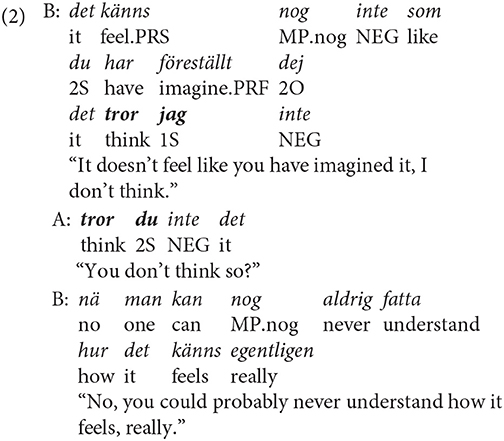
The first position evaluation of Speaker B is qualified by the phrase det tror jag inte (“that, I don't think”), which is paralleled in the subsequent turn by Speaker A, who utters tror du inte det? (“you don't think so?”). Dialogic parallelisms have bearing on the analysis of how epistemic forms (e.g., tro) are distributed in spoken discourse and how they refer to the epistemic perspectives of the speaker and the addressee. They are introduced in section The Dialogic Nature of Grammar along with the related notion of “diagraph” (Du Bois, 2014, p. 362).
The present paper explores the perspectivizing function of pronouns, modal particles, mental verbs, and sentence-type in egophoric contexts and argues for the importance of dialogicity for their description. It seeks to address the epistemic function of forms from the point of view of how knowledge is negotiated in discourse, in contrast to traditional descriptions of such forms, which focus on the mental representation of events of a solitary speaker. This paper shows that contexts involving the speech-act participants may be formally differentiated depending on which participant is in focus. Second-person contexts predominantly feature non-declarative clauses, the modal particle väl (“right?”), and formulaic expressions that mitigate statements that affect the addressee, as well as expressions that prompt the addressee to consider and sometimes agree with the point of view of the speaker (du vet). By contrast, first-person contexts are characterized by the predominance of declarative clauses, the modal particle ju (“of course”/“obviously”), and expressions that mitigate/attenuate and qualify statements that involve the speaker.
An original contribution of the present paper lies in demonstrating the distribution and frequency of epistemic forms (i.e., modal particles and mental verbs) as dependent on perspectivizing, indexical forms like egophoric pronouns and sentence-type distinctions (see section Perspectivizing Constructs and Their Distribution, below). Such patterns of distribution and frequency are analyzed from the functionality and meaning of the investigated forms, as portrayed in the literature (see Dahl, 2000; Bergqvist, 2020). The presentation of the results is qualitatively formulated and void of any advanced statistical modeling since the corpus data and the ensuing analysis must be regarded as explorative and preliminary with respect to the role of the observed patterns for a more detailed analysis of the studied forms.
The background for the ensuing data analysis details distinct notions such as dialogicity, stance, and egophoricity (Dahl, 2000; cf. San Roque et al., 2018), which serve as a theoretical backdrop for analyzing the central characteristics of the investigated forms. The following sections go on to explore egophoricity in spoken Swedish with special attention to the co-distribution of subject pronouns, modal particles, mental verbs, and sentence-type distinctions. These diverse resources signal the shared and private perspectives of the speech-act participants in distinct ways, as discussed in the concluding section of the paper.
The Dialogic Nature of Grammar
While the dialogic characteristics of language have been largely overlooked in descriptive, typologically oriented, linguistic research during the last half-century, early (modern) grammarians like Otto Jespersen have emphasized this aspect of language. He said, “The essence of language is human activity—activity on the part of one individual to make himself understood by another, activity on the part of that other to understand what was in the mind of the first…” (Jespersen, 1924, p. 17). Although contemporary, functionalist theories of grammar such as Role and Reference Grammar (Van Valin and LaPolla, 1997) and Functional Discourse Grammar (Hengeveld and Mackenzie, 2008) build on similar insights, typological-descriptive linguistics does not emphasize the importance of dialogic aspects of grammar. Additionally, the well-attested under-specification of meaning in linguistic form has had surprisingly little impact on descriptivist-typological research, possibly because taking it at face value would require more attention to be paid to pragmatics, which is a field of study with a partly different research agenda from mainstream, descriptive linguistics. Since a large part of the context relevant to an utterance rests on interactional and socio-cultural criteria, paying attention to the pragmatics of the utterance means paying attention to the speaker and the addressee. These two main players occupy inter-changeable roles, something that is reflected everywhere in grammar and in language use (see e.g., Couper-Kuhlen and Selting, 2018). These shortcomings of traditional descriptive-typological research have motivated John Du Bois and colleagues to formulate the theory of “Dialogic Syntax” (e.g., Du Bois, 2014) in order to explicitly account for dialogic structures within current functionalist investigations of grammar and language. Du Bois (2014) explores dialogicity in syntactic analysis, focusing on dialogic parallelisms and the partial reproduction of utterances by a previous speaker as supra-sentential structures that a fully accountable syntactic theory should include. He uses the following example to illustrate such parallelisms (Du Bois, 2014, p. 361):

Example (3) illustrates a dialogic parallelism by means of a partial reproduction by Speaker B of the previous utterance of Speaker A. The repetition of like in the utterance of B along with the co-referential function of pronouns (i.e., you and me refer to the same participant in the exchange) are the component parts of a diagraph (Du Bois, 2014, p. 362, see also Du Bois, 2007), which includes both positions of the turn (i.e., first and second positions). In the South Papuan language Nen, Evans (2012) accounts for the “assentive,” which is a grammaticalized form expressing assent to a foregoing imperative utterance. Evans draws parallels to question-answer pairs, interrogative-demonstrative exchanges, and egophoric marking (see section Egophoricity and Epistemic Authority, below) in order to situate this phenomenon2. Example (4) shows how the assentive (zero) morpheme occurs in “perfective, singular, positive responses to imperatives” (Evans, 2012, p. 176):
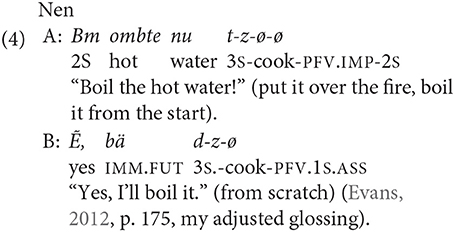
Assentives cannot be accounted for without making explicit reference to the preceding utterance, which makes up part of the immediate context. Assentives in Nen exemplify grammaticalized diagraphs, as defined by Du Bois, and Evans argues that typologically oriented research on morpho-syntax should include attention to structures of dialogic coordination in order to be able to capture similar phenomena. Assentives in Nen and parallelisms in American English are examples of distinct cross-turn structures and the present paper aims to contribute to the investigation of dialogicity in grammar by accounting for egophoricity in spoken Swedish in terms of the frequency and distribution of egophoric pronouns, modal particles, and sentence-type. These resources display clear dialogical functions that motivate comparisons to e.g., egophoric marking, as one instance of a diagraph.
Status, Stance, and Territories of Information
“Stance” is a term that has figured in the literature on modality and evidentiality (e.g., Biber and Finegan, 1989; Mushin, 2001; Cornillie, 2009; inter alia). In these contexts, stance is used to target the motivations speakers have for using certain epistemic forms, signaling the attitude of the speakers toward a talked-about event. In the context of the present paper, the stance concept provides an interaction-focused framework for analyzing distinct linguistic resources in spoken Swedish as primarily belonging to the perspective of one of the speech-act participants. The contents of this section motivate the subsequent analysis of forms as signaling the relative placement of epistemic authority with the speaker and/or the addressee.
While stance has been regarded, by many, as a vague concept with too many uses and no clear differentiation from related concepts, such as “viewpoint” and “subjectivity” (e.g., Kockelman, 2004), recent developments in conversation analytical research by John Heritage and colleagues (e.g., Heritage and Raymond, 2005; Heritage, 2012, 2013) have moved toward an operationalization of the stance concept to focus on how speakers position themselves with respect to the allocation of epistemic authority in talked-about events (cf. Goffman, 1981 and the notion of “principal” as a speaker-role). A central issue for Heritage (2012) is accounting for the relationship between sentence types vis-à-vis speech acts in spoken American English. The fact that speakers routinely use declaratives to formulate polar questions (see Stivers and Rossano, 2010) is a long-standing problem in pragmatics, and Heritage proposes a solution to this problem by introducing the two concepts: “epistemic status” and “epistemic stance.” Epistemic status designates a (more or less) stable property of the relation between the speaker and certain events, such as being married, being hungry, exercising a professional occupation, etc. (see directly below for more details; cf. Labov and Fanshel, 1977). Epistemic stance is the moment-to-moment positioning performed by the speaker with respect to his/her epistemic status, as well as that of other speech-act participants (Heritage, 2012). The relationship between epistemic status and stance produces a dynamic interplay, where a speaker can present himself/herself as an authority (stance) despite not being an authority based on his/her status, and vice versa. Both concepts (i.e., status and stance) may constitute grounds for claiming epistemic authority, which may also be placed with the addressee, or a third party, depending on context. Although the epistemic status of a speaker may warrant authority by default if it concerns the personal domain of the speaker, the epistemic stance adopted by the same speech-act participant may align or misalign with this epistemic status.
Kamio (1997) coins the concept “territories of information” to account for the factors that determine the preference for certain sentence types as reflecting the claim of knowledge of the speaker. Kamio observes how speakers of Japanese talk about events that belong to the respective territories of the speech-act participants and demonstrates the ungrammaticality associated with utterances targeting events that are outside the territory of the speaker without signaling this in the appropriate way by means of sentence-final particles and inflections (Kamio, 1997, p. 41). Territories of information, as identified by Kamio, are (1) information obtained from internal or direct experience; (2) detailed professional knowledge/expertise; (3) reliable information that one of the speech-act participants commits to; and (4) information about persons, objects, events, and facts close to one of the speech-act participants, including personal information (Kamio, 1997, p. 39). Kamio provides a scalar, linear representation of the psychological states of the speaker and the addressee and uses the value of 1 to indicate an event as closely belonging to the speaker and the value of 0 to signal one that does not belong to the speaker. The addressee has a corresponding scale and if an event (signaled by a bar in Figure 1, below) is judged to be close to 1 on the scale of the speaker and close to 0 on the scale of the addressee, then such an event belongs to the territory of the speaker. The letter n represents a neutral point on the scale, between 1 and 0.

Figure 1. Illustration of the territory of information of the speaker (after Kamio, 1997, p. 17).
Figure 1 may apply to many kinds of utterances, one of which could be, I am running a fever. When uttering this proposition, the speaker can assume an authoritative position with respect to his/her addressee, since a bodily state like fever automatically belongs to the affected person. However, such default positioning of authority may be challenged when seeing a doctor, who by profession can override the sensations of a patient (Heritage and Raymond, 2005)3. Kamio considers the theory to be, in principle, applicable to any language, although different grammatical resources are used to express this territorial difference, including evidentials (Kamio, 1997, p. 173). Heritage (2012) partly builds on the theory proposed by Kamio and uses a similar model for signaling the relative knowledgeability of the speaker and the addressee. Heritage's view of epistemic territories as they pertain to his exploration of epistemic status and stance is summarized in the following quote, “epistemic territories embrace what is known, how it is known, and persons' rights and responsibilities to know it” (Heritage, 2012, p. 5). The value of the insights provided by Heritage and Kamio, for the purposes of the present study, is to bring to light the simultaneous positions of the speech-act participants as part of a (potential) dialogic exchange, thereby extending the study of epistemic positioning to also include the perspective of the addressee.
Egophoricity and Epistemic Authority
Dahl (2000) defines egophoricity as reference to the speech-act participants (i.e., speaker and addressee) in discourse. This definition subsumes first person, second person, generic (you/one, Swe. man), and logophoric pronouns4. Egophoric reference in spoken Swedish as defined by Dahl focuses on reference to the speech-act participants (speaker/addressee) in terms of argument identity, but egophoricity also houses an epistemic aspect that concerns the speech-act participants' rights to knowledge. As suggested by the theory of epistemic status and stance proposed by Heritage, the speaker is in a privileged position to make assertions about events that primarily involve the speaker. Likewise, the speaker is required to concede authority to the addressee when the involvement in an event is focused on the addressee. This alteration of authority is grammaticalized in egophoric marking, a categorical expression that has been described for a small number of languages in different parts of the world (see Creissels, 2008; San Roque et al., 2018, for an overview). Example (5) illustrates the basic distribution of the egophoric marker (long vowel, ā) in Kathmandu Newar:
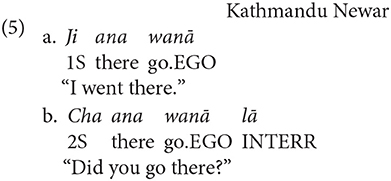
(Hale, 1980, p. 95).
The egophoric marker is found with first-person subjects in statements and with second-person subjects in questions, marking an alignment between the syntactic subject of the clause and the speech-act participant who is charged with epistemic authority. This kind of alignment usually requires a specific kind of (interchangeable) involvement on behalf of the speaker and the addressee, notably in terms of agency, control, and voluntary action. However, there is a high degree of attested variation in the type of involvement that conditions egophoric marking (see Bergqvist and Knuchel, 2017; cf. Creissels, 2008 for a discussion). Some languages restrict egophoric marking to occur with voluntary actions performed by one of the speech-act participants (e.g., Newar, given above), while other languages permit the egophoric marker to occur with any event that the speaker has authoritative knowledge of, including events that affect the speaker, as exemplified by Example (6) from Awa Pit, where -s is the egophoric marker:

The notion of (conscious) involvement, as a defining feature of egophoricity, encompasses not only volition but also affectedness and attitude as grounds for signaling epistemic authority. This feature is also what links egophoricity to evidentiality, where “performative” and “participatory” evidentials have been attested as constituting part of evidential paradigms in Amerindian and Papuan languages (Oswalt, 1986 for Pomoan; San Roque and Loughnane, 2012 for Papuan; cf. Bergqvist and Kittilä, 2017 for a discussion from the point of view of person marking). Using this broader conceptualization of involvement permits a comparison between disparate systems, assuming that they belong to the same functional domain (Givón, 1981, 2001), a view that is representative of the present investigation, which aims to show how epistemic aspects of egophoricity converge differently on the speaker and the addressee in spoken Swedish. The identified characteristics of face-to-face conversation (see section Introduction) serve as a guide to identify relevant properties of those parts of grammar that ground the interactions of the speaking subjects.
Egophoricity in Grammar: Examples from Spoken Swedish
As stated in the Introduction, the main argument of the present paper is that pronouns, modal particles, mental verbs, and sentence-type distinctions index aspects of the epistemic perspective of the speech-act participants. Their use in spoken discourse is expected to display discernible patterns that may contribute to the analysis of the investigated forms and the exploration of epistemic marking in language, more generally. The speech-act participants are especially prominent in discourse (see directly below), a fact that aligns with the relevance of dialogicity for analyzing grammar. Thus, egophoricity is an obvious starting point for exploratory work on epistemic marking in discourse.
Dahl (2000) investigates the occurrence of the egophoric arguments jag (1S), du (2S), and man (Gen) according to predicate type and valency and finds that the majority of all animate arguments in a corpus of Swedish conversations are egophoric. With mental verbs (e.g., veta “know,” tänka “think,” hoppas “hope”), the percentage of egophoric subjects is over 80% of all animate subjects, and with transitive verbs, egophoric subjects amount to 61%. Only with copular verbs (vara “be,” bli “become,” heta “be called,” finnas “be/exist”) is the percentage below 50%. With such verbs, “allophoric” reference (i.e., third person) is more common (Dahl, 2000, p. 47). Dahl finds support for the generalizability of these percentages in data sets of spoken English and Spanish, which reflect this distribution of egophoric pronouns. The main findings recorded by Dahl are that the majority of all animate subjects in spoken Swedish are egophoric, which is a fact that is restricted to conversations in spoken Swedish (in written Swedish, the percentage of egophoric arguments is substantially lower). The percentage of egophoric arguments is higher when an argument can only be animate (e.g., with mental verbs). Dahl concludes that the distribution of egophoric arguments in conversations cannot be accounted for by drawing on notions such as topicality and/or viewpoint but simply reflects how people talk and what they talk about.
The present paper is based on a corpus of spoken Swedish called “Conversations in Gothenburg” (Sv. Samtal i Göteborg). The corpus consists of 497,677 words, segmented into around 50,700 lines, which approximates turns. This is the same corpus that Dahl (2000) used to extract a sub-corpus of some 65,000 words that he called “the G corpus” (Dahl, 2000, p.41). The “Conversations in Gothenburg”-corpus was collected as part of a sociolinguistic project where speakers residing in the Gothenburg area were asked to record themselves while conversing with another person (see Löfström, 1988, for details). This method of data collection is unusual for spoken language corpora but produces highly naturalistic language use. Dahl tagged his sub-corpus of 65,000 words in order to be able to classify all arguments and predicates therein, whereas the full word corpus with half a million words used in the present investigation is not tagged and therefore does not permit a comparable precision search for relevant forms. The choice to use the “Conversations in Gothenburg” corpus was motivated not only by the ease of accessibility and previous familiarity but also by the naturalistic character of the spoken language data (see also Bergqvist, 2020).
In this section, four interrelated linguistic resources are discussed with respect to patterns of co-distribution and the egophoric properties of forms. These are subject pronouns (jag/du/man), modal particles (ju/väl), mental verbs (tro, veta, hoppas), and sentence-type (SV/VS, argument-predicate order). Combinations of these forms were extracted by hand with search strings of the kind, jag tror (“I think”) and tror jag (“[Do] I think”), for mental predicates (according to the SV/VS alternation). Modal particles are placed after the finite verb, which means that searches for subject pronoun and modal particle combinations are slightly less straightforward (see section Modal Particles and Subject Person, below; Bergqvist, 2020, for details). While a manual search of this kind is rudimentary, it was sufficient to uncover the patterns reported in this section and in the subsequent discussion summarizing the results. For the analysis of the investigated forms, the author relied on his native speaker competence and his ability to discern the illocutionary status of utterances and their effects in the investigated corpus (see directly below).
While egophoric contexts (i.e., ones that make reference to the perspective of the speaker and/or the addressee) display distributional and frequency characteristics that may be contrasted with allophoric contexts, there are also discernible differences between the linguistic representation of the involvement of the speaker and that of the addressee. As stated in the section directly above, the speaker may directly address their own beliefs and evaluations; but the same is not true for ones that belong to the addressee. This asymmetry has direct consequences for the distribution and frequency of constructs that reflect egophoricity.
Modal Particles and Subject Person
Modal particles have been attested for all Germanic languages and display formal and semantic characteristics that separate them from discourse particles (e.g., Zimmermann, 2011). Prominent syntactic and semantic features associated with modal particles in e.g., German, are a syntactic placement in the middle field, following the subject and finite predicate of the clause, and intersubjective semantics (e.g., Abraham and Leiss, 2012). Gast (2008) investigates the German modal particles ja, wohl, doch, and etwa and proposes a systematic classification of these as constituting “a system of oppositions with pairs of minimally contrasting elements” (Gast, 2008, p. 1). Gast identifies two semanto-pragmatic parameters, namely (i) strength of assertion and (ii) consistency with the relevant context, and argues that the forms differ in terms of how they align with some aspect of the referential context, and whether the utterance constitutes a strong or weak assertion and could be viewed as a fact, or as a hypothesis (Gast, 2008, p. 5). In accordance with this analytical model, Gast argues that ja and wohl both align with the relevant context (one aspect of which is shared knowledge/access) but that they contrast in terms of strength of assertion; ja marks factive utterances and wohl signals a hypothetical assertion.
Aijmer (1977) notes for the Swedish modal particles ju (“as you know”) and väl (“right?”), that the modal component contained in the term used to denote both particles is subordinate to their pragmatic function, viz. how an utterance should be interpreted by the addressee. Aijmer argues that the communicative function of ju and väl may be regarded as their primary meaning (Aijmer, 1977, p. 206), while also discussing the modal components of both forms, namely that ju marks propositions as fact and väl signals possibility. This characterization is comparable to the one subsequently offered by Gast for German, where the cognate particles may be contrasted in terms of strength of assertion (Aijmer, 1977, p. 207; cf. Gast, 2008, p. 5). Bergqvist (2020) picks up on the pragmatic analysis of ju and väl as signaling the epistemic authority of the speaker (ju) and the addressee (väl) in marking a proposition that is regarded as accessible to both speech-act participants (i.e., shared access/knowledge). The formal and distributional characteristics of ju and väl motivate an analysis of these forms as a closed paradigm within the (slightly) larger group of modal particles, which also includes nog and nu (see Bergqvist, 2020; cf. Lindström, 2008). In contrast to Aijmer and Gast, Bergqvist argues that the “modal” component inherent to the respective form may be analyzed in terms of “engagement” (Evans et al., 2018) rather than epistemic modality. The non-defeasible meaning feature of ju and väl can be stated in terms of shared accessibility (engagement), whereas the modal analysis of Aijmer of both forms in terms of fact/possibility is produced by the claim, or deferral of epistemic authority, according to Bergqvist. It is not the subjective attitude of the speaker toward a proposition in terms of certainty that is at stake; rather, it is the speaker's claim of knowledge of events that involve the speaker that motivates the use of ju and the speakers deferral to the addressee when referring to events that primarily involve the addressee, which motivates the use of väl. Both are exemplified in (7) and (8):
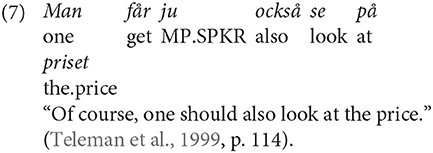

A syntactic property of Swedish modal particles is that they only occur in declarative sentences. Despite this fact, sentences with väl usually feature a question mark in written Swedish, in contrast to ju, which always is accompanied by a full stop. The syntactic status of sentences with ju and väl is identical, however, as seen in examples (7) and (8), directly above. This separates Swedish modal particles from German modal particles, where the cognate wohl may be used in questions, as well. We will return to the issue of implicit sentence-type in the modal particle väl in section Shared Perspective.
The primary function of ju and väl is, according to Bergqvist (2020), to signal the epistemic authority of the speaker and the addressee. This is visible in how they co-occur with subject pronouns in a corpus of spoken Swedish. Ju is predominantly used in contexts with jag (1S) and man (Generic), and väl is mostly found with du (2S). This tendency is strongest with man and du in terms of how they are co-distributed with ju and väl. Table 1 shows the co-distribution between egophoric pronouns and ju/väl in terms of percentages for respective combinations.

Table 1. Relativized comparison between jag/man/du and ju/väl (after Bergqvist, 2020, p. 490)a.
The numbers in Table 1 should be viewed against the total number of egophoric pronouns in the corpus, where jag (13,768) is roughly twice as common as du (7,248) and almost three times as common as man (4,805). Out of all the combinations of ju/väl with egophoric pronouns, man stands out with 49% of all occurrences with ju and 32% with väl, despite being much less frequent in number compared to jag and du. Du+väl accounts for 39% of all combinations of egophoric pronouns and väl, whereas jag+väl has the lowest percentage of all such combinations, with 28%. Man frequently combines with both ju and väl in accordance with its generic meaning, which aligns with the notion of shared access featured in ju/väl (Bergqvist, 2020, p. 491). The frequent combinations of man+ju/väl and du+väl are remarkable given the comparatively lower number of man/du pronouns in the corpus. It is evident that subject person co-varies with modal particles according to the demonstrated connection between egophoric reference and the respective epistemic territories of the speech-act participants. If this were not the case, then a more random distribution of forms would be attested. Instead, we see a clear patterning with egophoric pronouns and ju/väl that suggests a grounding of perspective with the speaker for ju and the addressee for väl. Both modal particles allocate epistemic authority in a context of shared access since this is a semantic feature of both forms. With mental predicates, this allocation is made differently, although there are functional overlaps between these and modal particles like ju/väl (see also section Shared Perspective, below).
Mental Verbs and Subject Person
This section starts from Dahl's (2000) observations regarding egophoricity in spoken Swedish discourse, where mental verbs are more likely to have egophoric arguments in comparison to copular verbs, which commonly have allophoric arguments. Dahl notes that egophoric arguments are differently distributed, where second person (du) is more common than first person (jag) with some mental predicates such as se (“see”), veta (“know”), vilja (“want”), and förstå (“understand”), whereas, propositional attitude verbs like tänka (“think”), tro (“believe”), and tycka (“think/feel”) are much more common with first person (jag) than second person (du). He speculates that mental verbs with complements containing shared knowledge favor first-person subjects, but he does not discuss this possibility in any detail. The role of shared vs. private perspectives in the distribution of mental verbs, such as tro (“believe”) and veta (“know”), is discussed in section Perspectivizing Constructs and Their Distribution, below.
Another factor that determines the distribution of egophoric arguments is syntax, specifically SV and VS predicate-argument order. The VS-order produces either an interrogative sentence or the fronting of a non-subject constituent. Dahl (2000) notes that parenthetical mental verbs (e.g., förstår du, “you see”; Dahl, 2000, p. 56) make up a large number of such (non-interrogative) cases. He also notes that du occurs much more often with VS order (302 out of 546 cases, i.e., 55%) than jag (170 out of 720 cases, i.e., 24%; see Dahl, 2000, p. 56). To what degree such instances are interrogative is not discussed in detail, neither are examples provided of syntactic fronting. Given the untagged nature of the corpus used in this investigation, it requires some manual counting in order to arrive at an answer to this question, and some instances remain difficult to classify. Despite these challenges, there are some telling patterns that can be observed in the corpus, as detailed in the sections directly below. The following sections only discuss present tense forms. These present tense forms are much higher in number (by an order of ten) than past tense forms, and given the stated focus on egophoric reference in the immediate discourse context, present tense forms are a natural starting point.
Tro (Think/Believe)
The majority of the 164 instances of the construction tror du (“[do] you think”) in the corpus are interrogative. Whether they convey polar questions, or if they request a more general response from the addressee, has not been determined for all instances given that the count is made from a text that does not indicate intonation and other prosodic cues relevant to making such distinctions. Out of 100 random examples of the VS-construction tror du (“[do] you think”), only three instances were of syntactic fronting (e.g., det tror du inte, “you don't think so”). The remaining 97 cases were all interrogative, requesting a response from the addressee. For the SV-construction du tror (“you think”) of which there are only 24 instances in the corpus, almost half convey a question despite being declarative by form. This aligns with previously discussed observations regarding the form-function correspondence in polar questions (see section Status, Stance, and Territories of Information, above). Examples of “declarative questions” in the corpus are så du tror att (“so you think that”) and du tror inte (“you don't think”).
The situation is altogether different for first-person jag, where the SV-construction jag tror occurs 553 times in the corpus and the VS-construction tror jag occurs 421 times. Out of one hundred random examples of the SV construction, no instances of declarative interrogatives were found. For the VS-construction tror jag, 160 out of 421 instances are examples of the phrase det tror jag (i.e., syntactic fronting). No instances of interrogative sentences were found in one hundred randomly selected examples of tror jag. Examples of SV and VS-constructions with first-person jag are shown in example (9):
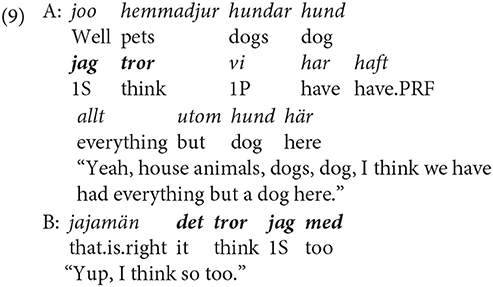
In addition to the syntactic difference between the first-position utterance, jag tror, in (Example 9; line 1) and the response turn, tror jag, in (line 2), we may view these as composing a single diagraph, where jag tror and the following response, det tror jag med, make up a unit that exists across the turn. Similar diagraphs are prevalent in spoken Swedish and they are suggestive of the interactional motivations for the use of epistemic expressions like jag tror that go beyond the subjective epistemic evaluation of the speaker (see section The Dialogic Nature of Grammar; Du Bois, 2014). The differences between first-person jag and second-person du in combination with a mental verb like tror may be stated in both absolute and relative frequencies. Out of 1,356 counted instances of tror, the egophoric pronouns (jag, du, man) account for 1,177 combinations, corresponding to 87% of all instances of tror. First- and second-person plural forms make up <10 instances, so these are grouped with third-person referents, for sake of simplicity. Table 2 shows how these combinations are divided according to subject person and sentence-type.
The numbers and percentages in Table 2 should be viewed against the total number of egophoric pronouns in the corpus, which, as stated in section Modal Particles and Subject Person, are 13,768 for jag, 7,248 for du, and 4,805 for man. As one might expect, first-person jag+tror is, by far, the most common, amounting to 72% of all combinations of tror and any argument; jag+tror is five times as common as du+tror. Man+tror only amounts to 1% of all instances. The very low co-occurrence of man and tror is most likely due to the generic function of man to presuppose a measure of generic-ness with respect to an event. The private character of tro does not permit genericity to be a prominent feature of utterances containing this verb (cf. Bergqvist, 2020). In fact, all mental predicates are infrequent with man, but to varying degrees. Sensory and cognitive predicates like se (“see”) and veta (“know”) have a higher percentage of arguments with man, as do volitional predicates like vilja (“want”). Reasons for these differences in frequency are discussed in section Private Perspective, below. Returning to the difference between the total number of egophoric pronouns in the corpus and their co-distribution with tro, the numbers in Table 2 indicate that their combination is primarily a means to signal the perspective of the speaker with respect to some event. This view is reinforced by the complete lack of interrogative sentences with the VS-construction (tror jag). All counted instances of this construction are examples of syntactic fronting (e.g., det tror jag med). The opposite holds for SV and VS-constructions with second-person du. Only a handful of non-interrogative phrases were found even with SV constituent order (du tror), which furthermore amount to <2% of all instances. This means that the overwhelming majority of all utterances that target the mental state of the addressee using the epistemic verb tror, do so by asking for the perspective of the addressee and their epistemic estimation of some talked-about event. With mental predicates, sentence-type has a clear perspectivizing function, which is predictable from their co-occurrence with egophoric arguments.
Veta (Know)
The mental verb veta (“know”) occurs with egophoric arguments in 76% of all cases, which is slightly lower than tro, which, as stated, combines with egophoric arguments in 87% of all sentences (see Table 2, above). The distribution of veta with first- and second-person pronouns differs in that jag+vet amounts to almost 36% of all cases and du+vet makes up just under 40% of all cases, making second-person du the most frequent argument with vet. The distribution of arguments with vet is in Table 3 and may be compared to the numbers in Table 2, above.
More than half of the 236 instances of the VS-construction vet+jag consist of det vet jag, i.e., an instance of syntactic fronting (128 of 236). No interrogative examples were found, mirroring the results for tror+jag in Table 2, above. All investigated instances of vet+jag are examples of syntactic fronting. In comparison, the VS-construction with second person, vet du, occurs 786 times, and only 63 instances consist of det vet du (“know you that”), suggesting that few of these cases are instances of the syntactic fronting VS-construction. However, vet du also functions as a discourse marker that occurs at the beginning and the end of utterances:
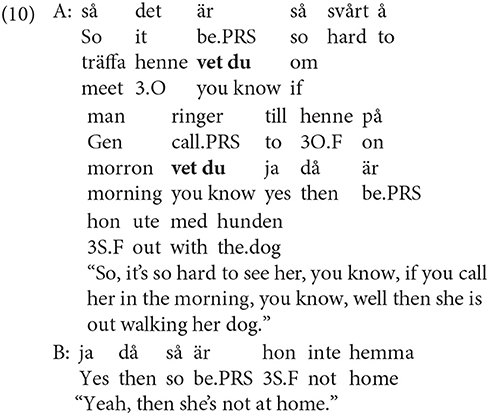
Vet du/vettu as a discourse marking expression introduces new information into the conversation, with an aim to establish a shared perspective between the speaker and the addressee (see Lindström, 2008, p. 65). This means that although the expression contains a second person marker (du), it signals the perspective of the speaker, albeit with an invitation for the addressee to share this perspective. The discourse regulating function of vet du/vettu to establish a shared perspective between the speech-act participants is further discussed in the subsequent sections, below.
The SV-construction jag vet occurs 765 times and is over three times as common as the VS-construction vet jag (236 instances). A total of 478 of these are constituted by jag vet inte (“I don't know”), which literally means that the speaker is unaware, or ignorant, of some event. However, the fact that this expression makes up 62% of the total number of instances of jag vet suggests its function as a discourse-marking expression:
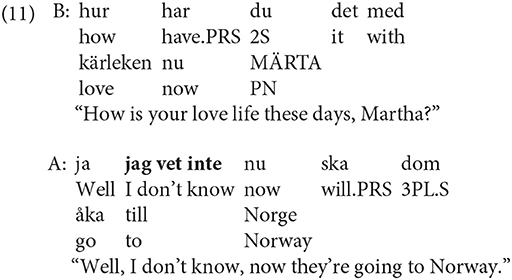
The expression jag vet inte in example (11) is uttered in response to a question, but it does not express the ignorance of the speaker as much as it signals their uncertainty with respect to answering the question. This function of jag vet inte to signal the epistemic uncertainty/ignorance of the speaker can be seen in (12), where jag vet inte is followed by jag tror inte in the same utterance by Speaker A. The preceding utterance by Speaker B is not a question or a request, so the response of Speaker A is not prompted by Speaker B but qualifies the knowledge of speaker A on the event talked about:
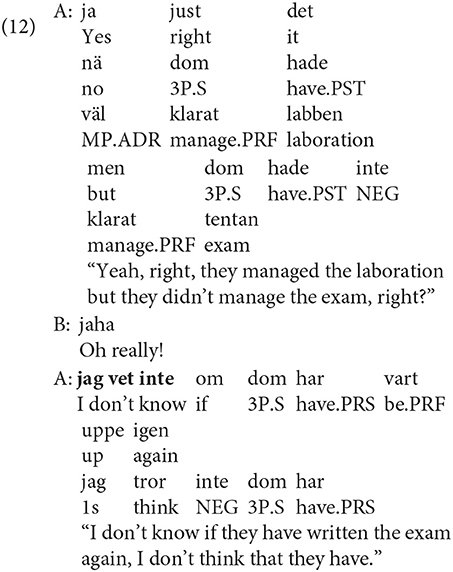
The relatively high number of vet combined with egophoric pronouns is connected to the semi-grammatical status of vet du and jag vet inte as discourse markers. Out of seven investigated mental predicates, vet occurs with the highest frequency (see also Table 3, section The Epistemic Perspective of the Addressee, below). Lindström (2008) mentions other discourse marking expressions such as tro (“think”) and vetja (“I know”), but there are relatively few instances of these expressions in the investigated corpus. The native-speaker intuition of the author suggests that vetja, and possibly tro as well, are somewhat archaic expressions, which are not used by speakers of Standard Swedish under 40 years of age.
Hoppas
The verb hoppas (“hope”) is not very frequent in the corpus and does not show any signs of developing into a discourse marking expression. Almost all of the 103 examples of hoppas are uttered from the perspective of the speaker, as indicated by either the first-person subject pronoun jag, the generic man, or the first-person plural pronoun vi. Many instances are also exclamative with pronoun-ellipsis, such as in example (13):
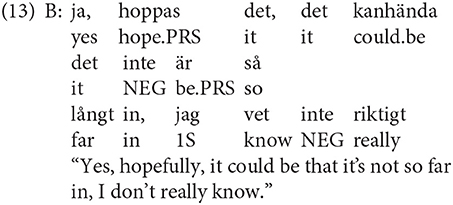
The expressions vi får hoppas/får vi hoppas/vi hoppas/hoppas vi (“we should hope”/“let's hope”) occur 24 times altogether, and given the low number of occurrences for vi with mental predicates (and in the corpus as a whole), this is a noticeable increase in frequency. In the corpus, this appears to be a formulaic expression, but not one has become grammaticalized like vet du/vettu [see section Veta (Know), above]. There are no instances of du (“you”) with hoppas, and there is only one instance of non-egophoric subject marking with hoppas in the corpus. This example is in (14), below:
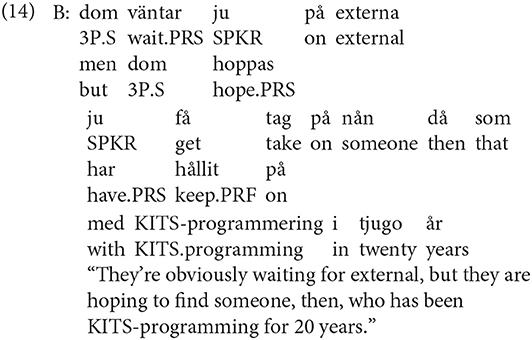
The distribution of hoppas with egophoric pronouns is special in the sense that it never occurs with du, but it combines with vi to a relatively higher degree than other mental predicates. The combination of vi and hoppas suggests a shared perspective that includes the addressee, permitting a functional comparison to vet du [see section Veta (Know), above]. Although second-person du is entirely absent with hoppas, this mental verb is not only exclusively used to express the positive expectations of the speaker but also those of the addressee.
The Epistemic Perspective of the Addressee
Mental verbs express various aspects of the beliefs, expectations, and desires of the speaker. As we have seen directly above, however, mental verbs display differences when it comes to attributing such states to the addressee. Some mental verbs, such as hoppas (“hope”), are almost never used with second-person subject pronouns, reflecting the reluctance of the speaker to exclusively attribute such internal states to the addressee. The preferred way to attribute “hoping” to the addressee is by using the first-person plural form vi. Tro refers to the private estimation of one of the speech-act participants and is almost always declarative with first-person jag and almost always interrogative with second-person du. The exclusive perspective of the speaker is, by far, most frequently referred to in the corpus. A verb like vet (“know”), on the other hand, occurs with second-person pronouns more often than with first-person pronouns. The combination of second-person du with vet mostly produces interrogative clauses, or instantiates the discourse particle vet du/vettu. This is in contrast with first-person pronouns, which mostly occur in declarative clauses and almost always convey statements. Vet in combination with du also has resulted in a discourse marker that indicates how the addressee should interpret an utterance. As such, it invites the addressee to share the estimation of the speaker of a novel proposition (see section Mental Verbs and Subject Person, above). There is thus a strong orientation toward the perspective of the addressee in the use of vet with second-person du.
These facts suggest that mental verbs may be arranged along a cline where the (explicit) attribution of primary perspective to the addressee goes from restricted to unrestricted. The notion of restricted attribution may be based on relative frequencies (percentages) and the predominance of a certain sentence-type in utterances with a given mental predicate. Table 4 features the number of instances of seven mental verbs occurring in the corpus. These are listed in the leftmost column. The co-distribution percentages with the egophoric pronouns jag and du (columns 3 and 6) are used to calculate the attribution number in the rightmost column. This column indicates the ratio between jag and du in combination with a given verb. For example, the verb tycka (“think”/“opine”) with du only amounts to one-tenth of the cases of tycka+jag. By contrast, the verb se (“see”) is two and a half times more common with du than it is with jag. The verb hoppas (“hope”) is not attested with du and therefore has no ratio value.
The figures in Table 4 indicate the preference of the speaker to attribute various aspects of belief, opinion, expectation, and sensory access to the perspective of the addressee, depending on the meaning of the lexemes. From the point of view of egophoricity, the perspective of the speech-act participants is non-randomly mapped onto different kinds of mental verbs, and although the list is far from complete, it suggests the attributability of mental states, as indicated by verbs of emotion, cognition, and perception. The numbers in Table 4 indicate that a perceptual verb like se (“see”) is commonly used to talk about the perception of the addressee. The same is true for veta (“know”), which targets the addressee's knowledge in interrogative clauses, or in the form of the discourse marker vet du/vettu. Interestingly, grammaticalized, direct evidential markers sometimes originate with verbs of seeing, and there are attestations of semantic overlap between seeing and knowing in such forms, which is in agreement with well-known metaphorical mappings such as “I see what you mean” (e.g., Matlock, 1989; cf. Aikhenvald, 2004). This semantic overlap is thus reflected in the distributional characteristics of se and veta in spoken Swedish.
Perspectivizing Constructs and their Distribution
Modal particles and mental verbs offer complementary views on how the perspective of the speaker and the addressee is expressed in language. Both resources map onto the subject person in ways that point to the pervasiveness of egophoricity and the special status of the perspective of the addressee. The main difference in perspective coneveyed by modal particles and mental verbs concerns shared and non-shared/private access. The modal particles ju/väl signal shared access to events and, at the same time, place epistemic authority with the speaker and the addressee, respectively. Mental verbs, on the other hand, are by definition private to the speaking subject to which they are referentially linked. In order to allocate the private perspective of belief, opinion, and expectation with the addressee, the speaker draws on resources such as sentence-type to signal that these private states are outside the domain of the speaker and belong to another speaking subject. The development of some combinations of mental verbs and subject pronouns into discourse markers, e.g., vet du (see section Mental verbs and Subject Person, above), is another way that the speaker can address the perspective of the addressee with the speaker maintaining their own perspective in the use of such forms (see section Hoppas, above).
Shared Perspective
When analyzing epistemic evaluations semantically, in terms of e.g., certainty, doubt, or ignorance, such expressions are almost always viewed from the perspective of the speaking subject. This analytical approach rests on a long philosophical tradition that treats the perspective of the other with caution, and in some parts of this tradition, the perspective of the speaker is even regarded as the only one that exists. Seen from the point of view of language use, however, it might not be warranted to assume that an exclusive/private speaker-stance is default when it comes to qualifying knowledge of events. There are in fact data that suggest otherwise, namely that knowledge is regarded as non-exclusive in casual conversations and that any claim of exclusive knowledge is marked in such contexts (see e.g., Zariquiey, 2015, for a discussion of genre in Kakataibo). The frequent use of ju and väl in spoken Swedish supports the view that shared access to events is commonplace in spontaneous conversations. However, the distribution of ju and väl in spoken Swedish also suggests that shared access to events does not equate symmetrical access to such events. In terms of frequency, ju is more common, which is a fact that coincides with the prevalence of the perspective of the speaker in spoken discourse as indicated by the high number of first-person subject pronouns (jag) and the generic pronoun man. This means that speakers explicitly mention themselves more often than their addressees and that assertions containing the modal particle ju align with this predominance of speaker perspective. Bergqvist (2020) argues that ju encodes shared access to events along with the epistemic authority of the speaker, and väl encodes shared access and the epistemic authority of the addressee. The allocation of epistemic authority to reside with the addressee is predominantly with reference to events that involve the addressee as an actor, or affected party. This is reflected by the high number of co-occurrences of du and väl. The study conducted by Bergqvist (2020) also suggests that the placement of epistemic authority with the addressee commonly is conceptualized as speaker uncertainty or estimated probability (see e.g., Gast, 2008, for the German cognate wohl) but that these concepts are defeasible and that the epistemic authority of the addressee is not. The quasi-interrogative function of väl to indicate a question, despite always occurring in declarative clauses, is also produced by the semantic feature of addressee authority. This is an expected result since the primary function of sentence-type is to request an assertion by the addressee based on his/her perspective, especially with events and actions that involve the addressee. The assertion of the speaker, while included in the use of väl, is by definition subordinate to the perspective of the addressee (assumed).
Private Perspective
The analysis of the mental verbs tro (“believe”), veta (“know”), and hoppas (“hope”) above shows that these occur with different frequencies and that they are differently distributed with respect to egophoric pronouns (see section The Epistemic Perspective of the Addressee). Based on frequency and distribution, the verb veta is more readily available for talking about the epistemic perspective of the addressee than tro. While tro displays the highest number of combinations with egophoric arguments, amounting to 87%, only 14% consist of tro+du. The relatively restricted number of occurrences of tro+du along with the predominance of this combination in interrogative contexts (VS, see Table 1, above) suggests that the speaker prefers to address the epistemic territory of the addressee (i.e., their beliefs) by way of placing epistemic authority with the same. This allocation of epistemic authority is achieved by asking the addressee for their beliefs by means of formally interrogative utterances (e.g., tror du inte dom skulle vilja göra det då?), or by declarative questions (cf. Stivers and Rossano, 2010). Talking about the beliefs of the addressee is not preferred unless these are addressed in the form of a question. This observation confirms the theory of stance proposed by Heritage (2012; see section Status, Stance, and Territories of Information), where an alignment between the epistemic status and stance of a speaker is unmarked in conversation. Utterances targeting the knowledge of the addressee by using veta are less restricted, and combinations of veta+du are also much more common than tro+du. Almost 40% of all instances of veta combine with du, and VS-combinations of veta+du amount to twice the number of SV-combinations. Most of the former are interrogative rather than instances of syntactic fronting; the opposite is true for combinations of veta and jag. Veta is also found in two frequently occurring discourse markers: vet du/vettu and jag vet inte. Vet du/vettu marks new information with an invitation for the addressee to share the perspective of the speaker, a function that bridges a private predicate like veta to modal particles like ju and väl. Based on frequency and distribution, a predicate like veta is less private than tro, suggesting the connection between knowing and a verifiable fact, compared to belief and subjectively estimated possibility.
Concluding Discussion and Summary
Perspective-taking is pervasive in grammar, and various forms of epistemic marking (modal, evidential, or egophoric) convey epistemic perspectives in terms of authority, either by claiming it, disclaiming it, or assigning it to another speech-act participant (see Bergqvist and Kittilä, 2020). Important aspects of assuming a perspective can be seen in dialogic exchanges between the speech-act participants, where parallelisms and the partial reproduction of previous utterances are used in the negotiation of epistemic authority. A diagraph that features the mental verb tro is seen in Example (2), repeated here. The two phrases, namely det tror jag inte (line 1) and tror du inte det (line 2) illustrate a pattern of epistemic alignment where the distribution of the epistemic modal verb tror depends on the subject person, sentence-type, and turn position:
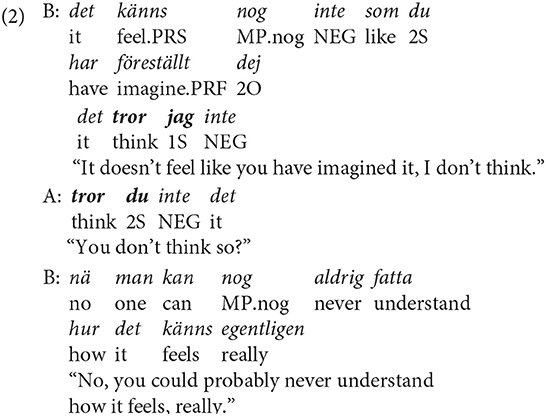
Speaker B addresses the (future) emotional state of Speaker A by qualifying his/her statement with the modal particle nog (“probably”) and the phrase det tror jag inte. Speaker A focuses on the belief of Speaker B by uttering tror du inte det?, prompting Speaker B to elaborate on their position, which they do in the subsequent line. The perspectivizing property of epistemic markers is thus visible in parallelisms, such as in (2), where the expectations and considerations relevant to the respective positions of the speech-act participants are reflected in the use of mental verbs like tro. In the present paper, three formally distinct perspectivizing resources, namely modal particles, mental predicates, and sentence-type are analyzed from how they situate the perspective of the speaker and the addressee with respect to talked-about events. Patterns that emerge from the co-distribution of such forms with egophoric subject pronouns (jag/man/du) indicate the epistemic perspectives implicit in these pronouns. The modal particles ju and väl occur with jag/man/du in non-random ways in accordance with the proposed semantics of both forms, i.e., shared access from the perspective of the speaker and the addressee, respectively. Complement-taking mental predicates are differently distributed against jag/du and can be analyzed from their capacity to reflect consideration of the perspective of the addressee. Two of the most common mental verbs are vet and tror, both of which occur with egophoric pronouns more than 75% of the time but display differences with regard to their co-distribution with jag/du. Tror/vet+du conveys a question, whereas tror/vet+jag almost never does. This patterning strongly suggests the epistemic function of sentence-type in egophoric contexts, i.e., when events involving the addressee are addressed. In addition, vet+du has developed into a discourse marker with intersubjective connotations and occurs with a much higher frequency than tror+du. These distributional patterns and resulting grammaticalization paths contribute analytical aspects to the study of epistemic marking that is amiss in traditional descriptive accounts of such markers.
Data Availability Statement
Requests to access these datasets should be directed to HB,aGVucmlrLmJlcmdxdmlzdEBsaW5nLnN1LnNl.
Author Contributions
The author confirms being the sole contributor of this work and has approved it for publication.
Funding
This study was supported by Swedish Research Council (dnr. 2017-01969) and the Marcus and Amalia Wallenbergs Minnesfond (MAW 2017.0081).
Conflict of Interest
The author declares that the research was conducted in the absence of any commercial or financial relationships that could be construed as a potential conflict of interest.
Footnotes
1. ^Multiple perspective consists of (grammatical) constructions that “encode potentially distinct values, on a single semantic dimension, that reflect two or more distinct perspectives or points of reference” (Evans, 2006, p. 99).
2. ^Evans calls egophoric marking “conjunct/disjunct”, which is a commonly used label for referring to such systems in the literature (e.g., Hale, 1980).
3. ^The exemplified conditions for claiming epistemic authority based on the epistemic status of the speaker, target states of some kind. Given the definition by Heritage of epistemic status as revolving around states of knowing, internal sensation, and (personal) identity, this may appear to be a definitional trait. However, the epistemic status of one of the speech-act participants does not have to rely on having knowledge, or talking about personal sphere of a person. Epistemic status can be produced by the involvement of a speaker in some event without necessarily drawing on personal standing and previous experiences, although such factors, of course, color most interactions.
4. ^Logophoric pronouns signal co-reference between subjects in main and subordinate clauses, e.g., Davidi said hei[logophoric] will go to the party, and have been attested for not only many African languages (e.g., Dimmendaal, 2001) but also in languages of the Circum-Baltic area, e.g., Eastern Vidzeme and Leivu Estonian (Wälchli, 2015).
References
Abraham, W., and Leiss, E. (eds.). (2012). Modality and Theory of Mind Elements Across Languages (Trends in Linguistics Studies and Monographs 243). Berlin: Walter de Gruyter. doi: 10.1515/9783110271072
Aijmer, K. (1977). Partiklarna ju och väl [The particles ju and väl]. Nysvenska Studier 57, 205–216.
Bergqvist, H. (2015). “Epistemic marking and multiple perspective: an introduction. Special Issue: Epistemic marking in typological perspective,” in Language Typology and Universals (STUF), H. Bergqvist, and L. S. Roque, 123–141.
Bergqvist, H. (2020). Swedish modal particles as markers of engagement: evidence from distribution and frequency. Folia Linguist. 54, 469–496. doi: 10.1515/flin-2020-2047
Bergqvist, H., and Kittilä, S. (2017). Person and knowledge: introduction. Open Linguist. 3, 18–30. doi: 10.1515/opli-2017-0002
Bergqvist, H., and Kittilä, S. (eds.). (2020). “Epistemic perspectives: evidentiality, egophoricity, and engagement,” in Evidentiality, Egophoricity, and Engagement (Studies in Diversity Linguistics 99) (Berlin: Language Science Press), 1–21.
Bergqvist, H., and Knuchel, D. (2017). Complexity in egophoric marking: from agents to attitude holders. Open Linguist. 3, 359–377. doi: 10.1515/opli-2017-0018
Biber, D., and Finegan, E. (1989). Styles of stance in English: lexical and grammatical marking of evidentiality and affect. Text 9, 93–124. doi: 10.1515/text.1.1989.9.1.93
Cornillie, B. (2009). Evidentiality and epistemic modality: on the close relationship of two different categories. Funct. Lang. 16, 32–44. doi: 10.1075/fol.16.1.04cor
Couper-Kuhlen, E., and Selting, M. (2018). Interactional Linguistics: Studying Language in Social Interaction. Cambridge: Cambridge University Press.
Creissels, D. (2008). Person variation in Akhvakh verb morphology: functional motivation and origin of an uncommon pattern. STUF 61, 309–325. doi: 10.1524/stuf.2008.0027
Curnow, T. J. (2002). Conjunct/disjunct marking in Awa Pit. Linguistics 40, 611–627. doi: 10.1515/ling.2002.025
Dahl, Ö. (2000). Egophoricity in discourse and grammar. Funct. Lang. 7, 37–77. doi: 10.1075/fol.7.1.03dah
Dimmendaal, J. G. (2001). Logophoric marking and represented speech in African Languages as evidential hedging strategies. Aust. J. Linguist. 21, 131–157. doi: 10.1080/07268600120042499
Du Bois, J. (2007). “The stance triangle,” in Stancetaking in Discourse, ed R. Engelbretson (Amsterdam: John Benjamins), 139–182. doi: 10.1075/pbns.164.07du
Du Bois, J. (2014). Towards a dialogic syntax. Cogn. Linguist. 25, 359–410. doi: 10.1515/cog-2014-0024
Evans, N. (2006). View with a view: Towards a typology of multiple perspective. Berk. Linguist. Soc. 32, 93–120. doi: 10.3765/bls.v31i1.3429
Evans, N. (2012). “Nen assentives and the problem of dyadic parallelisms,” in Practical Theories and Empirical Practice: Facets of a Complex Interaction, ed A. C. Schalley (Amsterdam: John Benjamins), 159–83. doi: 10.1075/hcp.40.07eva
Evans, N., Bergqvist, H., and San Roque, L. (2018). The grammar of engagement I: framework and initial exemplification. Lang. Cogn. 10, 110–140. doi: 10.1017/langcog.2017.21
Gast, V. (2008). “Modal particles and context updating: the functions of German ja, doch, wohl and etwa,” in Modalität und Grammatikalisierung, eds O. Letnes, E. Maagerø, and H. Vater (Trier: Wissenschaftlicher Verlag), 153–177.
Givón, T. (1981). Typology and functional domains. Stud. Lang. 5, 163–193. doi: 10.1075/sl.5.2.03giv
Givón, T. (2001). Syntax: An Introduction, Vol 2. Philadelphia, PA: John Benjamins Publishing Company.
Grzech, K., Schultze-Berndt, E., and Bergqvist, H. (eds.). (2020). Knowing in interaction: empirical approaches to epistemicity and intersubjectivity in language. Folia Linguistica 54, 281–315.
Hale, A. (1980). “Person markers: finite conjunct and disjunct forms in Newari,” in Papers in Southeast Asian Linguistics 7, ed R. Trail (Canberra, ACT: Pacific Linguistics), 95–106.
Hengeveld, K., and Mackenzie, L. J. (2008). Functional Discourse Grammar: A Typologically-Based Theory of Language Structure. Oxford: Oxford University Press. doi: 10.1093/oxfordhb/9780199544004.013.0015
Heritage, J. (2012). Epistemics in action: action formation and territories of knowledge. Res. Lang. Soc. Interact. 45, 1–29. doi: 10.1080/08351813.2012.646684
Heritage, J. (2013). “Epistemics in conversation,” in Handbook of Conversation Analysis, eds J. Sidnell and T. Stivers (Oxford: Wiley-Blackwell), 370–94. doi: 10.1002/9781118325001.ch18
Heritage, J., and Raymond, G. (2005). The terms of agreement: indexing epistemic authority and subordination in assessment sequences. Soc. Psychol. Q. 68, 15–38. doi: 10.1177/019027250506800103
Kockelman, P. (2004). Stance and Subjectivity. J. Linguist. Anthropol. 14, 127–150. doi: 10.1525/jlin.2004.14.2.127
Labov, W., and Fanshel, D. (1977). Theraputic Discourse: Psychotherapy as Conversation. New York, NY: Academic Press.
Leech, G. (1998). “English grammar in conversation,” in Proceedings of the Chemnitz Symposium 20-21 February 1998, eds J. Schmied and A. Wilson (Chemnitz University of Technology).
Lindström, J. (2008). Tur Och Ordning: Introduktion Till Svensk Samtalsgrammatik. Stockholm: Norstedts.
Löfström, J. (1988). Repliker Utan Gränser: Till Studiet av Syntaktisk Struktur i Samtal [Boundless Conversational Exchanges: A Contribution to the Study of Syntactic Structure in Conversation]. Gothenburg: University of Gothenburg dissertation.
Matlock, T. (1989). “Metaphor and the grammaticalization of evidentials,” in Proceedings of the Fifteenth Annual Meeting of the BLS (Berkeley Linguistics Society.), 215–225.
Mushin, I. (2001). Evidentiality and Epistemological Stance: Narrative Retelling. Amsterdam: John Benjamins. doi: 10.1075/pbns.87
Oswalt, L. R. (1986). “The evidential system of kashaya,” in Evidentiality: the Linguistic Coding of Epistemology, eds W. Chafe and J. Nichols (Norwood, NJ: Ablex Pub), 29–45.
San Roque, L., Floyd, S., and Norcliffe, E. (2018). Egophoricity. Amsterdam: John Benjamins. doi: 10.1075/tsl.118.01san
San Roque, L., and Loughnane, R. (2012). The New Guinea Highlands evidentiality area. Linguist. Typol. 16, 111–167. doi: 10.1515/lity-2012-0003
Stivers, T., and Rossano, F. (2010). Mobilizing response. Res. Lang. Soc. Interact. 43, 3–31. doi: 10.1080/08351810903471258
Teleman, U., Hellberg, S., and Andersson, E. (1999). Svenska Akademiens Grammatik [Grammar of the Swedish Academy], Vol. 4. Stockholm: Norstedts.
Van Valin, R. D., and LaPolla, R. J. (1997). Syntax: Structure, Meaning and Function. Cambridge: Cambridge University Press. doi: 10.1017/CBO9781139166799
Wälchli, B. (2015). Logophoricity in eastern vidzeme: the literary latvian idiolect of andrievs niedra and leivu estonian. Baltic Linguist. 6, 141–192. doi: 10.32798/bl.397
Zariquiey, R. (2015). The encoding of addressee's perspective in Kakataibo (Panoan, Peru). Lang. Typol. Univers. 68, 143–164. doi: 10.1515/stuf-2015-0008
Keywords: egophoricity, epistemic marking, dialogicity, Swedish, modal particles
Citation: Bergqvist H (2021) Egophoricity and Perspective: A View From Spoken Swedish. Front. Commun. 6:627144. doi: 10.3389/fcomm.2021.627144
Received: 08 November 2020; Accepted: 07 April 2021;
Published: 14 May 2021.
Edited by:
Petra Hendriks, University of Groningen, NetherlandsReviewed by:
Lotte Hogeweg, Radboud University Nijmegen, NetherlandsElisabeth Engberg-Pedersen, University of Copenhagen, Denmark
Copyright © 2021 Bergqvist. This is an open-access article distributed under the terms of the Creative Commons Attribution License (CC BY). The use, distribution or reproduction in other forums is permitted, provided the original author(s) and the copyright owner(s) are credited and that the original publication in this journal is cited, in accordance with accepted academic practice. No use, distribution or reproduction is permitted which does not comply with these terms.
*Correspondence: Henrik Bergqvist, aGVucmlrLmJlcmdxdmlzdEBsaW5nLnN1LnNl
 Henrik Bergqvist
Henrik Bergqvist
